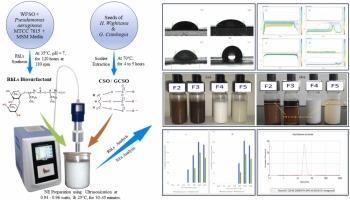Industrial Crops and Products ( IF 5.6 ) Pub Date : 2024-06-29 , DOI: 10.1016/j.indcrop.2024.118885 Samadhan P. Patil , Sammed A. Bhalerao , Yogeshsing N. Rajput , Amit P. Pratap

|
Presently, Industrial-scale demands for manufacturing rhamnolipids (RhLs) are not so developed; probably due to the high cost of the substrates and the rare demand for costlier surfactants. Therefore, the use of waste frying oils (WFSO) as substrates in RhLs manufacturing using Pseudomonas aeruginosa could be a notable substitute for the regularly used sources of oils and fatty acids to minimize manufacturing charges. WFSO as a byproduct normally consists of Linoleic acid as a prime fatty acid constituent. In the present work, P. aeruginosa yielded RhLs at an uttermost concentration of 7.4 g L−1; while constructional characteristics proved the presence majority of di-RhLs in the mixture. Also, on testing, the SFT (Surface Tension) reduced to 34.6±0.1 mN m−1; and an interfacial tension against heptane went down to 5.2±0.05 mN m−1. The oils from kernels of Hydnocarpus Wightiana and Garcinia cambogia were extracted separately; further, the detailed analysis showed the presence of their corresponding active fatty acids. In the initial screening of antifungal efficacy against Fusarium oxysporum (fusarium wilt) and Diplodia maydis (Diplodia ear and stalk rot of maize), RhLs shown the minimum inhibitory concentration (MIC) between 250 and 500 ppm, both extracted oils shown the MIC between 5 % and 10 %. Therefore, we decided to prepare the nanoemulsions (NEs) using 0.5 % RhLs, and 10 % of each respective extracted oil; which upon analysis showed the globule size as low as 110.9 nm and 147.0 nm respectively. The turbiscan study revealed that NEs made using RhLs as an adjuvant were found more stable than the alkyl polyglucosides, and the nanoemulsions containing RhLs showed higher levels of antifungal activity against F. oxysporum and D. maydis in the antifungal study. Thus, a successful utilization of the WFSO for the production of RhLs; and reduction in the probable water or soil pollution was achieved, as well as our RhLs bio-synthesis cost was much less as compared to the existing manufacturing process.
中文翻译:

使用 WFSO 生产鼠李糖脂及其在使用 Hydnocarpus Wightiana、Garcinia Cambogia - 种子油开发抗真菌纳米乳液中的应用
目前,工业规模生产鼠李糖脂(RhLs)的需求尚未成熟;可能是由于基材的高成本以及对昂贵的表面活性剂的需求很少。因此,使用废煎炸油 (WFSO) 作为使用铜绿假单胞菌制造 RhL 的底物可能是常用油和脂肪酸来源的显着替代品,以最大限度地降低制造成本。 WFSO 作为副产品,通常由亚油酸作为主要脂肪酸成分组成。在本工作中,铜绿假单胞菌产生的 RhLs 浓度最高为 7.4 g·L −1 ;而结构特征证明混合物中存在大部分二-RhL。另外,经测试,SFT(表面张力)降低至34.6±0.1 mN·m −1 ;对庚烷的界面张力降至5.2±0.05 mN·m −1 。分别从大风果和藤黄果仁中提取油;此外,详细分析表明存在相应的活性脂肪酸。在针对尖孢镰刀菌(枯萎病)和玉米二倍体(玉米二倍体穗腐病)的抗真菌功效的初步筛选中,RhLs 显示的最低抑菌浓度 (MIC) 在 250 至 500 ppm 之间,两种提取油的 MIC 在 5 之间%和10%。因此,我们决定使用 0.5% RhLs 和 10% 的每种提取油来制备纳米乳液 (NEs);分析显示球体尺寸分别低至 110.9 nm 和 147.0 nm。 turbiscan 研究表明,使用 RhLs 作为佐剂制成的 NE 比烷基多糖苷更稳定,并且含有 RhLs 的纳米乳剂对尖孢镰刀菌和 D. 表现出更高水平的抗真菌活性。 抗真菌研究中的玉米。因此,成功利用 WFSO 生产 RhL;并且减少了可能的水或土壤污染,并且与现有的制造工艺相比,我们的RhLs生物合成成本要低得多。











































 京公网安备 11010802027423号
京公网安备 11010802027423号